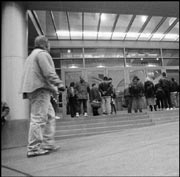IT’S NOT YET 9 a.m. and Walter—a blue bedroll hanging from his shoulder—is already outside the downtown public library, waiting to get in. The bearded 48-year-old has had two shots of vodka this morning, not a lot by his standards, and remains sober enough to peruse his daily hangout. He usually knocks back three or four newspapers a day before taking on a book; he’s partial to mystery and espionage novels.
As a homeless man, Walter recognizes he is one of the most common types of library patrons there is. “On some days, you can walk through the place and 80 or 90 percent of the people will be homeless,” he says of the downtown facility, temporarily located in the Convention Center while a grand new building is under construction.
Is that a problem? Not in and of itself, administrators are at pains to say, but a growing incidence of disorderly conduct has fueled their resolve to address the library’s status as a de facto homeless drop-in center by the time the new downtown branch opens in 2003. The library has doubled its security staff this year, moved toward more consistent enforcement of rules, and perhaps most importantly, joined forces with housing advocates and downtown merchants to pressure the city into fulfilling unmet demand for homeless drop-in services.
“We’re trying to walk a fine line,” says Laurie Brown, the library’s head of operations. “We don’t want to be coldhearted. At the same time, we’re trying to manage the library environment so that it can be used for true library purposes.”
A consultant’s report prepared for the city this fall painted a grim picture of that environment. “Library staff report that the downtown library has become an increasingly unwelcoming and even violent place,” it reads. “Assaults, drug use, and sexual misconduct occur in hallways, stairways, elevators, and among the book stacks. Employees and patrons are harassed.”
For example, in the month of September, library security reports show 78 incidents throughout the system (43 of them downtown), including three assaults, two indecent exposure/sex acts, and one threat of force.
The library’s Brown says “the incident that really brought it home” was a fight between two patrons last winter in which one stood up brandishing a knife. “We often have people who threaten to kill each other or staff members,” she adds, particularly when an unruly patron is asked to leave. At the Henry Library on Capitol Hill this spring, a rash of drug use in the bathroom left a trail of syringes and blood drippings.
For the most part, however, staff members say the library is dealing with less frightful offenses: Patrons attempt to bring in large bundles of belongings that can block the aisles, tie up seats by dozing off, or monopolize bathrooms by washing up or doing their laundry in the sinks.
But library officials actually seem to be trying hard to maintain a good relationship with the homeless. “We definitely don’t want the library to be a place where [homeless] people feel like they can’t come,” says board member Linda Larson. Tim Harris, of homeless newspaper Real Change, recalls a recent forum during which a librarian urged the largely homeless crowd to take advantage of the library’s books as well as computers.
Staff members nonetheless say that they have neither the mission, the training, nor the facilities to handle the social service needs of their homeless patrons, many of whom appear to be coming to the library because they have no place else to go during the day. There are about two dozen drop-in and hygiene centers in town, but they are swamped, leaving unmet the needs of at least a couple hundred people a day, according to the consultant’s report prepared for the city. Moreover, these centers are oriented around limited visits to meet survival needs, not all-day sojourns offering socialization and entertainment, as are possible at the library.
Backed by the coalition of library administrators, merchants, and homeless advocates, City Council member Nick Licata has been pushing for the construction of a new multipurpose day center for the homeless. The council has agreed in principle but as yet has failed to come up with funding.
Meanwhile, library officials are doing what they can to ensure that the new multimillion-dollar downtown branch will be a safer and friendlier place. In addition to stepped-up security measures, they are designing the building according to a more open plan that leaves few spaces where people can hide out and engage in illicit behavior. And they are continually trying to define the library’s role as a public facility in a big modern city with a diverse population. “The library of 2001 is not the library of 1954,” says operations head Laurie Brown. “We’re trying to figure out: What is the library of 2001?”








